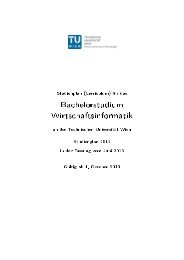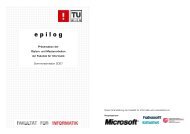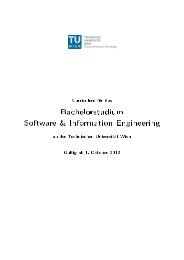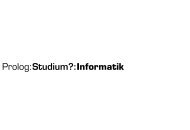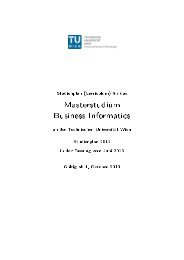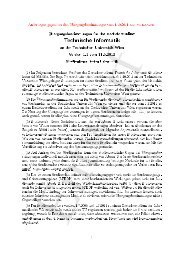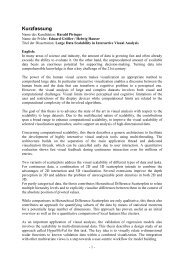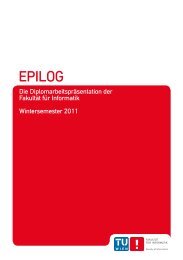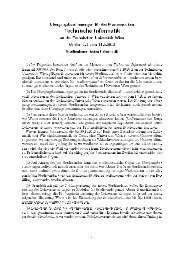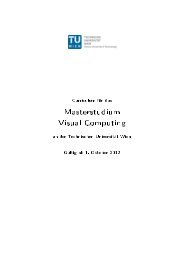Abstract-Band - Fakultät für Informatik, TU Wien - Technische ...
Abstract-Band - Fakultät für Informatik, TU Wien - Technische ...
Abstract-Band - Fakultät für Informatik, TU Wien - Technische ...
Sie wollen auch ein ePaper? Erhöhen Sie die Reichweite Ihrer Titel.
YUMPU macht aus Druck-PDFs automatisch weboptimierte ePaper, die Google liebt.
Institut <strong>für</strong> Softwaretechnik und Interaktive Systeme<br />
Arbeitsbereich Information & Software Engineering<br />
Stefanie Beyer<br />
Towards automated digital alibis<br />
Studium: Masterstudium Software Engineering & Internet Computing<br />
BetreuerIn: Privatdoz. Dr. Edgar Weippl<br />
In recent years, society is using media and communication technology more.<br />
One consequence of this is that there is more opportunity for its abuse, as well<br />
as use in crime. If there is more criminal usage of digital communication<br />
technology, we need to reliably be able to use digital evidence in both prosecutions<br />
and criminal defence cases. The main focus of this study is to show that<br />
forging of digital alibis is possible, which can impact on the reliance on digital<br />
evidence. The creation of a digital alibi using automation is the focus of other<br />
studies, and we are also looking at: social interaction during the simulation of a<br />
users behaviour, and whether behaviour can be simulated realistically and with<br />
limited computer evidence of the simulation. For this purpose an alibi framework<br />
is created that mimicked a typical users behaviour. This automation is<br />
intended to be implemented in such a way that it may not be possible to<br />
decide whether the traces of exercising actions recorded on the computer<br />
originate from either: a human user or a simulated user. Furthermore, forensic<br />
analysis is applied to verify whether the framework leaves any traces behind<br />
that could indicate the usage of a simulator. Social interaction is simulated by<br />
using a chatbot which used email and messaging and analysed the computers<br />
for their performance in creating a digital alibi. The performance criteria for the<br />
framework was based on metrics taken from real person computer behaviour.<br />
By evaluating the forensic analysis of simulated users hard drive and the real<br />
persons behaviour, it turned out that the simulator fits in the average range of<br />
real persons for nearly all categories. Therefore, simulation of users behaviour<br />
is possible, on condition that determining the sources of digital evidence is<br />
hard to verify. However, having a closer look at social communication, there is<br />
room for improvement, e.g. the chatbots text comprehension and email<br />
content.<br />
Peter Michael Bodesinsky<br />
Visualization of Compliance with Medical Guidelines<br />
Studium: Masterstudium Medizinische <strong>Informatik</strong><br />
BetreuerIn: Ao.Univ.Prof. Dr. Silvia Miksch<br />
Clinical guidelines recommend applicable actions in a specific clinical context.<br />
Computer Interpretable Guidelines (CIG) aim to achieve guideline integration<br />
into clinical practice and to increase health care quality. Analyzing compliance<br />
59



